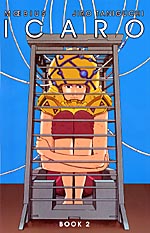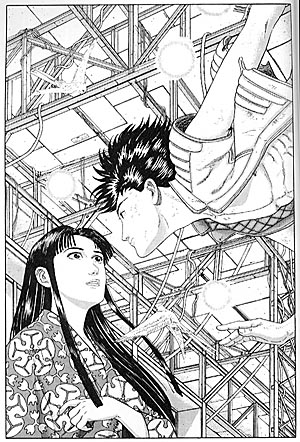 Written by Moebius
Written by Moebius
Art by Jiro Taniguchi
160 pages, black and white
Published by iBooks, Inc.
If you asked people what superpower they’d want to have, I think flight would be one of the top choices. There’s something liberating about the idea of being able to fly—that you can somehow escape the grasp of the world around you and instantly go wherever you want. French comics legend Moebius certainly understood that when he wrote Icaro, a two-volume collaboration with Japanese artist Jiro Taniguchi where a child is born with the power of flight… but without the power of liberation.
Icaro has grown up his entire life in a complex where his every movement is studied. That’s because of his ability to fly, tied somehow into his brain in a manner that no one can understand. Icaro has never seen the outside world before, and has no idea what he’s missing. When he falls in love with one of the lab technicians, though, it sets in motion a daring attempt to escape—but will Icaro, like his namesake Icarus, fly too high and fall?
Moebius’s story in Icaro is in many ways pretty slight: Icaro is raised in captivity, falls in love with Yukiko, and tries to escape with her. The strength of Icaro is very much in the Taniguchi’s visuals, and Moebius is writing to his artist’s strengths. And yet… there’s something very fun about the little details that Moebius puts into the story. There’s a strange subplot about terrorists who are genetically engineered to explode that never really goes much of anywhere, for instance, or a doctor who wants to operate on Icaro’s brain that maps out the different sections of the brain on his own bald head. As someone who had drawn other people’s scripts as well as his own larger-than-life ideas in the past, though, Moebius seems content here to be the one envisioning stories that play to his collaborator’s strengths.
 Taniguchi’s art in Icaro is, to put it bluntly, gorgeous. Just in the foreground, we’ve got some incredible images of Icaro floating through the air, and the people around him reacting. You can see the awe and fear reflected on their faces, telling Moebius’s story as perfectly as possible. With Taniguchi’s razor-thin ink lines, there’s an amazing attention to detail here that makes everyone look almost like they’re from photographs with its exactness, but without losing sight of how to draw motion and having naturalistic art. And if seeing Icaro fly through the air and escape his captors in dramatic fashions was all we got, I’d be perfectly satisfied. It’s not, though. Taniguchi apparently is incapable of just focusing on the foreground of his art, and the end result is some of the most finely detailed backgrounds you’ll see this side of Geof Darrow. Just staring at all the little girders and catwalks with three-bar railings is fascinating; it’s mind-boggling when you think about just how long it must have taken to draw every page. At the same time, though, Taniguchi remembers that these are backgrounds, and never lets the overshadow what’s going on in each panel. Looking at his art, he’s truly a master of the sequential art form.
Taniguchi’s art in Icaro is, to put it bluntly, gorgeous. Just in the foreground, we’ve got some incredible images of Icaro floating through the air, and the people around him reacting. You can see the awe and fear reflected on their faces, telling Moebius’s story as perfectly as possible. With Taniguchi’s razor-thin ink lines, there’s an amazing attention to detail here that makes everyone look almost like they’re from photographs with its exactness, but without losing sight of how to draw motion and having naturalistic art. And if seeing Icaro fly through the air and escape his captors in dramatic fashions was all we got, I’d be perfectly satisfied. It’s not, though. Taniguchi apparently is incapable of just focusing on the foreground of his art, and the end result is some of the most finely detailed backgrounds you’ll see this side of Geof Darrow. Just staring at all the little girders and catwalks with three-bar railings is fascinating; it’s mind-boggling when you think about just how long it must have taken to draw every page. At the same time, though, Taniguchi remembers that these are backgrounds, and never lets the overshadow what’s going on in each panel. Looking at his art, he’s truly a master of the sequential art form.
You’ll want to read the two-volume set of Icaro twice. The first time through, you’ll find yourself pulled into the story of a boy trying to escape and discover the freedom that his power of flight has denied him all these years. You’ll thrill to his movements across the page, and turn each page quicker and quicker as the tension grows. And then you’ll read it a second time once you’ve reached the conclusion, to really appreciate every line that Taniguchi drew. This is an absolutely beautiful piece of art, and I’m thrilled that it’s now available in English. Something this beautiful should be seen by all.
Purchase Links:
